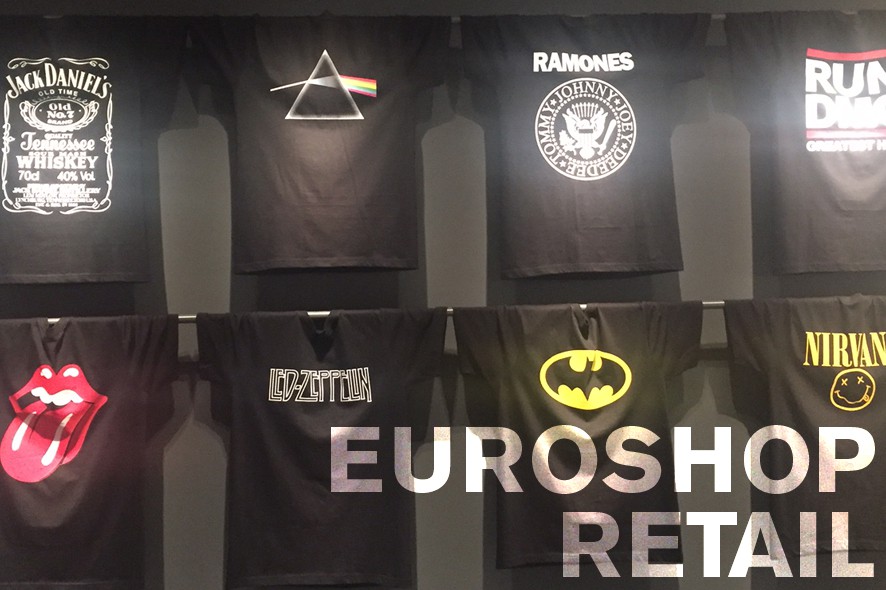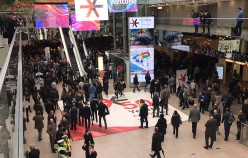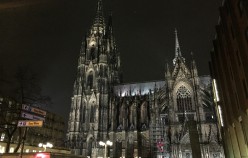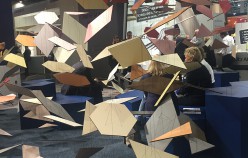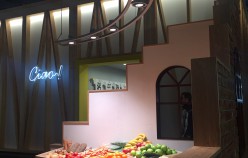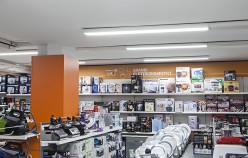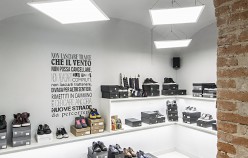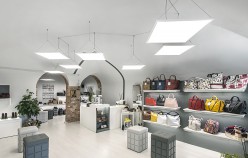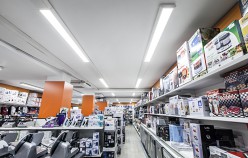In early March, the Euroshop fair was held in Dusseldorf, an international event devoted to the retail sector, that is shop furniture and visual merchandising in all aspects. We were there, with a particular focus on the lighting sector, so we are going to tell you some market trends and innovations.
Visiting the most important fairs in our sector, even when we are not part of them, is always useful. The Euroshop fair, now in its nineteenth edition, held once every three years, was celebrating its 50th birthday (it looks great). This fair attracts an international audience with a high percentage of decision makers of the retail industry, as well as architects, planners, designers and general contractors. With a total exhibition area of 127.000 square meters, in which more than 2.300 companies from over 60 nations exhibited their products, the exhibition areas were organized into categories, such as Shopfitting and store design, Pop Marketing, Expo & Event Marketing, Visual Merchandising, Food Tech & Energy Management, Retail Technology and, of course, lighting.
A pavilion and a half was devoted to lighting, a new formula from that of previous years, which saw the lighting sector scattered throughout the fair. Thus, this one was a much more comfortable and easier exhibition for visitors, who could focus their visit to the fair in their areas of interest.
If we talk about retail, the goal today is to provide stores with personality, real, live, customized and often unique shops. Stores often include art objects, preferring the use of natural and recycled materials and offer other products and services within the store itself, expanding its role and use. The visit to a shop must become primarily an experience: narration and emotion are included in the selection of solutions to be adopted, in the decision of the products to display or the concepts that a store (or brand) wants to convey. The light obviously contributes to this effect and to the primary purpose of stores: make people buy.
Talking about retail, we want to share with you two of the latest Plexiform projects: for Expert City in Cesano Maderno we decided to use “Trado“; for Sua Maestà Shoes, in Busca, we thought Futura – hanging version – was perfect to illuminate the products. You can find both projects in our gallery, after the Euroshop photo reportage.
The retail sector is growing and expanding in the furniture – lighting sector but, certainly, it was not spared from the crisis and, in particular, the e-commerce competition. One of the key topics of the event was certainly the meeting / clash with the technology. From the one hand, the means and devices that a store has to use to be always attractive and to win the competition of the online shop; on the other hand, the addition, right inside the store, of the technology through the digitization of the purchase process or digital light, for example.
We increasingly see the combination and connection between light and technology. From the one hand, light control system, such as the DALI system and the domotics; on the other hand, the internet of things which is now a reality that has become part of our lives.
How light can affect the purchasing process has been studied and analyzed by a department of the Zumtobel group, with a research entitled Limbic Lighting. The research, carried out in collaboration with a German clothing company that has analyzed the behavior of its customers at its stores, has led to the evidence that light can affect the purchasing process of a consumer. By creating different types of lighting in the showroom, they investigated what are the parameters of the light that have more effect, and which light scenes are more effective on an emotional level, depending on different types of customers. Among other things, it was found that even minimal changes of the scenarios, almost imperceptible, are enough to cause very different reactions in them. And, above all, they found that different types of customer are associated to different lighting projects. Thus, it is a light tailored to the customer or group of customers.
Another issue related to light and to its development in technology is the IoT, internet of things. That is the ability to adjust the lighting fixtures in consideration of external light. At different times of the day (and therefore different physical needs of people) different types of light are needed. They change the intensity or hue of color, preferring for example a shade of cold light in the morning or a softer and warmer light towards the afternoon / evening.
Studies conducted on the shades of light and the color rendering (reported with the CRI value, color rendering index, on the devices) are particularly important in the retail environment. Several companies presented very colorful stalls and stands, showing how sometimes even with the same machine you can create different lighting scenes, getting different effects on the merchandise. This is the case of the dynamic white, namely the ability to mix different diodes inside the LED (and, therefore, within the same device) and modulate power, thus obtaining hot or cold light depending on the requirement specification. Thus, we are talking about tailored light in all sectors for all times of the day and for all types of consumer. Could we call it liquid light?

 English
English Italiano
Italiano